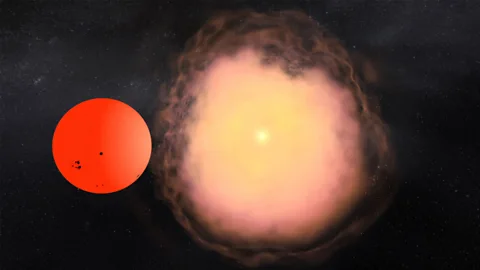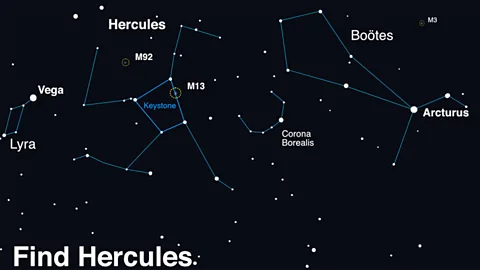Move over, solar eclipse: Scientists predict a once-in-a-lifetime nova explosion in the coming months
 Nasa
NasaThe nova T Coronae Borealis explodes about once every 80 years.
While the world's attention has been focused on the total solar eclipse that will occur later this spring, the distant Corona Borealis binary system – which contains one dead white dwarf star and one ageing red giant star – has been busy gearing up for its own moment of glory: a spectacular nova explosion.
Located 3,000 light years from Earth, the Corona Borealis is home to a white dwarf star named T Coronae Borealis (or T CrB for short) that's on the verge of what Nasa says will be a once-in-a-lifetime nova eruption.
The rare cosmic event is expected to take place sometime before September 2024. When it occurs it will likely be visible to the naked eye. No expensive telescope will be needed to witness this cosmic performance, says Nasa.
T CrB oubursts only happen about once every 80 years, the last was was back in 1946.
"I'm very excited. This thing is kind of like Halley's Comet – it occurs once every 75 to 80 years – but novas don't get the press Halley's Comet gets," says Nasa’s meteoroid environment program manager William J Cooke. "Comets always get more press."
How do scientists know when nova explosions will occur?
In most cases, Nasa experts have no idea when nova explosions are going to happen, says Cooke. But there are about 10 novas that are known as "recurrent novas", he explains.
"A recurrent nova is a nova that periodically blows its top," continues Cooke. "And T Coronae Borealis is a prime example."
But how does Nasa know with such certainty that T CrB is going to erupt over the next few months specifically? It's a matter of mathematical calculations and visible evidence. For instance, the last time T CrB experienced a nova was in 1946 – 78 years ago. The clock is very much ticking.
There's another sign that T CrB is getting ready to blow also, Cooke says. "We know that before it goes nova it dims for about a year, and T Coronae Borealis started dimming back in March 2023, so that's why we think it's going to go nova between now and the end of September."
 Nasa
NasaT CrB's reliable nova recurrence rate sets it apart from the many other novas identified over the years – and is part of what makes the star explosion so special.
"There are lots and lots of nova that have been discovered, but most haven't been known to recur. Or they go such long time periods without recurring that we don't know when they will again," explains Meredith MacGregor, an assistant professor with Johns Hopkins' William H. Miller III Department of Physics and Astronomy, who specializes in stellar activity.
The time span for a repeat performance of a nova can be anything between one year and as much as a millions of years, adds Richard Townsend, professor of astronomy at the University of Wisconsin-Madison.
What triggers a nova event?
In addition to knowing when some of the more predictable nova events like T CrB's will occur, Nasa experts also know why they happen. The white dwarf T CrB, for instance, exists in a binary system, meaning it is one of two stars orbiting around each other. The other is the red giant.
White dwarfs have masses similar to the Sun, but have a diameter around a hundred times smaller, making them comparable in size to Earth, he says. And that high mass but relatively small size makes a white dwarf's gravity especially strong.
As the red giant in T CrB's system ejects matter, T CrB's gravity attracts or collects it and puts it on its own surface, doing so for years and years, until it reaches its limit.
"What's happening in the system is that the red giant star is dumping all of this material onto the surface of the white dwarf," says Cooke. "And when too much gets on the surface of the white dwarf (T CrB) you literally get a thermonuclear reaction, like in a bomb, and the white dwarf blows off that material."
Townsend offers a similar description, explaining that once a sufficient amount of material has accumulated on T CrB and its temperature reaches a few million degrees Celsius, a nuclear fusion reaction begins burning, creating the highly visible nova event many are now eagerly anticipating.
"These are the same reactions that are ongoing in the core of the Sun, and they release a tremendous amount of energy in the surface layers of the white dwarf," says Townsend. "The energy release causes the white dwarf to temporarily outshine its red giant companion, and the overall light output from both stars – when seen here on Earth – increases by a factor of between a thousand and 100,000."
This type of outburst event helps Nasa experts understand the mass transfer that takes place between stars in binary systems and the thermonuclear explosions that result when the white dwarf goes nova. It's a process that in the case of T CrB happens again and again.
"It keeps going through this cycle of accumulating material from the bigger star over and over again," says MacGregor. "It usually takes thousands of years to build to the point where you see a nova. But T Coronae Borealis seems to do it much faster, which makes it a rare one."
What you'll see when the T CrB nova occurs
The T CrB star system normally has a visibility magnitude +10 in terms of brightness, according to Nasa. But when the upcoming T CrB nova eruption takes place, the visibility will jump significantly, up to what's known as a magnitude +2, which is far brighter than a +10. To put that into some context, a +2 is a similar level of brightness as the North Star, Polaris.
By the time that happens, T CrB will be visible to the naked eye.
Those hoping to see the nova display should look in the sky for the constellation Corona Borealis, or the Northern Crown – a small, semicircular arc near Bootes and Hercules, says Nasa. "This is where the outburst will appear as a 'new' bright star," the space agency explains.
More like this:
But don't be mistaken: what's occurring is not actually the formation of a new star. Rather, T CrB is simply becoming visible to us thanks to these far-off nuclear reactions.
"It's a star that already exists. The star has always been there, but to us it looks like there's suddenly a new star because we can't always see it," MacGregor explains. "White dwarfs are so small we cannot see them with the naked eye. But because of the fusion reaction that's occurring, we're temporarily able to see it. You could go out in your driveway at night and see this."[1]
Once T CrB's brightness reaches its peak it could even be as bright as the planet Mars, adds Cooke. And it is expected to remain fiery and visible to the unaided eye for at least a few days, but its explosive event could very well last more than a week.
And then, once the white dwarf rids itself of all the material it's accumulated from the larger red star, T CrB will once again dim into obscurity, unseen for decades more…
--
If you liked this story,sign up for The Essential List newsletter – a handpicked selection of features, videos and can't-miss news delivered to your inbox every Friday.
